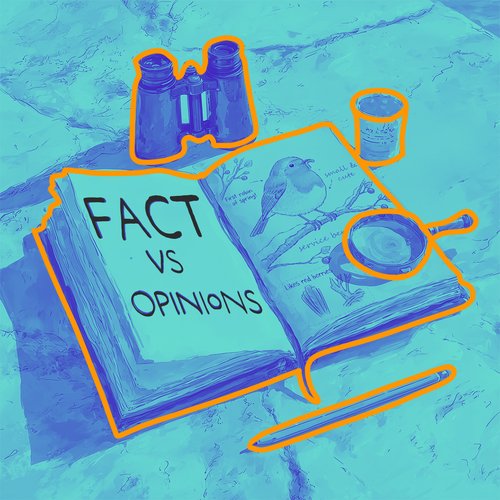
This lesson includes multiple activities to include in a classroom lesson on fact vs. opinion. Students will have the opportunity to work together as a class, in small groups, and independently to practice.
Use this lesson during media literacy units, and before student research projects. This lesson can be paired with an existing curriculum for English and History units.
This lesson will help students’ learn how to analyze sources for accuracy. Students will practice how to rule out facts from opinions through classroom discussions and games.
It is crucial for students to learn the necessary skills to analyze media carefully. With the rise of social media, misinformation, and online propaganda, it’s more important than ever to view media with a critical eye.
Open the lesson with a class discussion on facts versus opinions.
Create a T-chart to write down ideas. Together, discuss the definitions of a fact and opinion, show. Afterwards, brainstorm your own definitions and come up with examples as a class.
Ask students to share a time where they believed something that turned out to not be true. How did you find out? How did you feel?
Using the Detective Badge Exit Ticket Template, ask the students to write a fact, opinion, and one thing they remembered from the lesson.
This resource is part of the Elementary Express Toolkit geared toward Grades 3-6.
Journalism is the activity of gathering, assessing, creating, and presenting news and information.
Ethical journalism strives to ensure the free exchange of information that is accurate, fair and thorough. An ethical journalist acts with integrity. Ethical journalism should be accurate and fair. Journalists should be honest and courageous in gathering, reporting and interpreting information.
Belief that someone or something is reliable, good, honest, effective, etc.
Prejudice in favor of or against one thing, person, or group compared with another, usually in a way considered to be unfair.
An obligation or willingness to accept responsibility or to account for one's actions.
Awareness of the elements of environment through physical sensation or intuitive cognition. A capacity for comprehension and understanding.
People are attracted to information that helps them make good decisions. If you like music, you find musician interviews relevant. If you’re looking for a job, the business news is relevant. We need to depend on relevant information that helps us make decisions.
A conversation between two or more people where the purpose is to gather information and facts. The interviewer asks questions and the interviewee provides information based on their knowledge about a specific topic or issue.
An account of past or current events. In journalism, stories are presented with a combination of people, facts, and typically includes a beginning, middle and end.
The availability of facts or information indicating whether a belief or proposition is true or valid
Something that is known or proved to be true.
A view or judgment formed about something, not necessarily based on fact or knowledge.
An investigation into and study of sources in order to establish facts and reach new conclusions.
A source is an individual, company, document or more that can provide information to fuel a new story. In order for a story to be considered verified and to maintain a reputation as a news outlet, it is important to have a credible source.
Free from mistake or error. Coverage of topics and facts in appropriate detail.
The process of verifying the accuracy of a piece of information.
A desire to learn and know about something or anything.
Civics teaches the principles—such as adherence to the social contract, consent of the governed, limited government, legitimate authority, federalism, and separation of powers—that are meant to guide official institutions such as legislatures, courts, and government agencies. (NCSS D2.Civ.7.9-12 - D2.Civ.10.9-12)
Determine the kinds of sources that will be helpful in answering compelling and supporting questions, taking into consideration multiple points of view represented in the sources, the types of sources available, and the potential uses of the sources. (NCSS D1.5.9-12)
Students leverage technology to take an active role in choosing, achieving and demonstrating competency in their learning goals, informed by the learning sciences. (ISTE)
Students critically curate a variety of resources using digital tools to construct knowledge, produce creative artifacts and make meaningful learning experiences for themselves and others. (ISTE)
Whether students are constructing opinions, explanation, or arguments, they will gather information from a variety of sources and evaluate the relevance of that information. (NCSS D3.1.9-12 - D3.2.9-12)
Historical understanding requires recognizing this multiplicity of points of view in the past, which makes it important to seek out a range of sources on any historical question rather than simply use those that are easiest to find. It also requires recognizing that perspectives change over time, so that historical understanding requires developing a sense of empathy with people in the past whose perspectives might be very different from those of today. (NCSS D2.His.4.9-12 - D2.His.8.9-12)
Journalism
Media Literacy
Education
Tutorials
Lessons
Beginner
White board, chalkboard or other visual board
Markers
Slides
Projector
Online Worksheet
Internet
Notebook
80 Minutes or Two Parts (part one - finding facts & part two - understanding opinions)